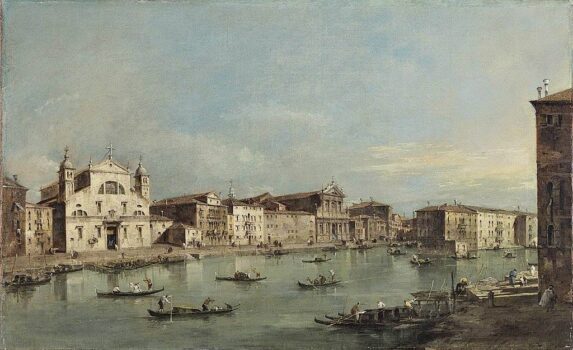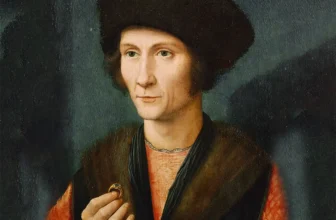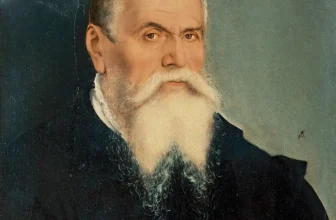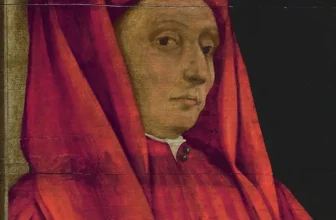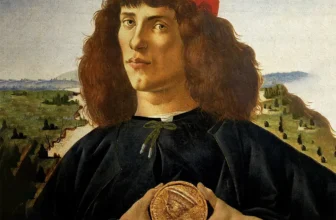Francesco Guardi: The Venetian Master of Light, Memory and Emotion
Francesco Guardi (1712–1793) stands among the final great masters of the Venetian school, a painter whose shimmering views of Venice captured not only the architecture and landscape of the city but also its spirit, atmosphere, and fleeting moments. While his contemporary Canaletto painted Venice with precision and topographical accuracy, Guardi approached the same subject with poetic emotion , transforming cityscapes into dreamlike visions. His work remains one of the most significant bridges between Rococo sensibility and the emerging Romantic movement.
Today, Francesco Guardi’s paintings are among the most coveted treasures of 18th-century Italian art. His views of Venice, known as vedute, sell for millions at international auctions, admired for their sparkling brushwork, atmospheric haze, and timeless evocation of the “Queen of the Adriatic.”
In this article, we will explore Francesco Guardi’s life, artistic evolution, his most famous artworks, and how much his paintings are worth in today’s art market.
Early Life and Family Background
Francesco Lazzaro Guardi was born on October 5, 1712, in Venice, Italy, into a family deeply rooted in the arts. His father, Domenico Guardi, was a painter from the Trentino region, and after his death in 1716, Francesco was raised by his mother along with his brothers Gianantonio Guardi (1699–1760) and Nicolò Guardi, both painters as well. The Guardi family workshop was active and prolific, producing altarpieces, religious scenes, and decorative works.
Francesco trained under his older brother Gianantonio, who had established himself as a respected artist in Venice. Initially, the Guardi brothers collaborated on large-scale religious and mythological compositions for Venetian churches and noble patrons. However, as Francesco matured, his artistic interest began to shift from the grand to the intimate , from religious narrative to the living pulse of the city around him.
Transition to the Vedute Genre
In mid-18th century Venice, there was a growing demand for vedute , panoramic city views , driven largely by the Grand Tour. Wealthy travelers, particularly from England and France, sought visual souvenirs of their journeys through Italy, and Venice, with its canals, bridges, and palaces, was the crown jewel.
At that time, Giovanni Antonio Canal, known as Canaletto, dominated the vedute market with his meticulously detailed, almost photographic depictions of Venice. Guardi, who likely studied Canaletto’s methods, initially followed this realistic approach. However, his temperament and vision soon led him to a distinct, more expressive style.
While Canaletto captured Venice as it was, Guardi painted Venice as it felt. His brushwork loosened, his colors softened, and light became an emotional element rather than a technical one. Through subtle haze, flickering reflections, and gentle distortion, Guardi’s paintings conveyed the city’s vitality and impermanence , an aesthetic that would later influence the Impressionists of the 19th century.
Francesco Guardi’s Artistic Style and Technique
Guardi’s unique style emerged in the 1750s and matured over the next two decades. His art can be identified by several hallmark features:
Vibrant, broken brushstrokes:
Guardi often used short, dappled strokes to create the illusion of movement, especially in water and sky. This technique gave his works a sense of immediacy and life.Atmospheric perspective:
He masterfully blended light and shadow to evoke the soft, humid air of Venice. Distant buildings fade into misty horizons, enhancing the poetic tone.Emotional realism:
Unlike Canaletto’s architectural precision, Guardi painted Venice as if seen through memory , shimmering, fluid, and transient.Warm color palette:
Guardi preferred warm ochres, deep blues, and silvery greys, evoking both the splendor and melancholy of the decaying Republic of Venice.Dynamic compositions:
His scenes often included lively human figures , gondoliers, merchants, and travelers , adding rhythm and storytelling to his cityscapes.
These stylistic traits made Francesco Guardi’s work stand out not just as a documentation of place, but as an emotional interpretation of Venice at the twilight of its power.
The Venetian Spirit in Guardi’s Paintings
Francesco Guardi painted Venice not merely as a physical location but as an idea , a living, breathing organism shaped by light, history, and water. His art reflected the melancholic grandeur of an aging city that still glittered with faded glory.
Many of his works depict familiar Venetian landmarks , the Piazza San Marco, Grand Canal, Doge’s Palace, and Rialto Bridge , but each feels different depending on the weather, light, and time of day. In this way, Guardi anticipated the modern artistic fascination with atmosphere and subjectivity.
His later works, particularly from the 1780s, reveal a looser, almost abstract quality, as though the physical world were dissolving into pure light. For this reason, critics often describe him as a proto-Impressionist, ahead of his time by nearly a century.
Most Famous Artworks by Francesco Guardi
Though Guardi produced a vast number of paintings throughout his life, several masterpieces stand out for their artistic brilliance and historical importance. Below are some of his most celebrated works:
1. The Doge’s Palace and the Riva degli Schiavoni
One of Guardi’s signature compositions, this painting shows Venice’s political heart in full splendor. The Doge’s Palace dominates the scene, bathed in golden light, with boats gliding across the lagoon and citizens bustling along the waterfront. Guardi’s airy brushwork transforms architectural solidity into a dance of reflections and atmosphere.
Today, multiple versions of this scene exist in museums such as the Louvre, National Gallery, London, and Metropolitan Museum of Art, New York.
2. The Grand Canal with the Rialto Bridge
This painting captures one of the most iconic views of Venice , the Grand Canal bustling with gondolas beneath the elegant arch of the Rialto Bridge. Unlike Canaletto’s structured symmetry, Guardi’s version is animated, almost musical, as sunlight ripples across the water and clouds drift overhead.
3. The Lagoon with the Torre di Malghera
Painted around 1770–1780, this work showcases Guardi’s atmospheric mastery. The distant tower and boats are rendered with minimal detail, yet the entire composition vibrates with life and luminosity. It demonstrates how Guardi used suggestion rather than description , a key precursor to modern landscape painting.
4. The Bucintoro Returning to the Molo on Ascension Day
This grand ceremonial painting illustrates the Sposalizio del Mare (“Marriage of the Sea”), a traditional Venetian festival symbolizing the city’s dominion over the Adriatic. The Doge’s magnificent barge, the Bucintoro, glides majestically across the lagoon. Guardi’s dynamic treatment of the water, sky, and festive crowd transforms this official subject into a symphony of light and color.
5. View of the Church of Santa Maria della Salute
One of Guardi’s most lyrical works, this painting focuses on Venice’s famous domed church, silhouetted against the shifting sky. The balance between architecture and atmosphere reveals Guardi’s sensitivity to both structure and emotion. This subject was a favorite of later Venetian painters as well, including J.M.W. Turner.
Francesco Guardi and His Influence on Later Art
Although Francesco Guardi was celebrated during his lifetime, his reputation grew even stronger in the 19th and 20th centuries, when art critics began to see him as a visionary precursor to modernism. His use of fragmented brushwork, hazy contours, and emotional tone influenced later painters such as:
J.M.W. Turner (1775–1851) – Turner’s atmospheric seascapes owe much to Guardi’s Venetian skies and luminous waters.
Claude Monet (1840–1926) – The Impressionists’ fascination with light, reflection, and fleeting perception echoes Guardi’s poetic approach to the cityscape.
John Singer Sargent (1856–1925) – Sargent’s watercolor scenes of Venice carry Guardi’s spirit of movement and mood.
In essence, Guardi’s art stands at a crossroads between the disciplined observation of the Enlightenment and the emotional subjectivity of Romanticism , an enduring bridge between eras.
Recognition and Legacy
Francesco Guardi died in Venice on January 1, 1793, at the age of 80. By that time, the Republic of Venice was nearing its end, soon to be conquered by Napoleon in 1797. Guardi’s paintings thus preserve the final visual memory of Venice’s glory before its political collapse.
Today, his works are housed in some of the world’s leading art institutions, including:
The Louvre Museum (Paris)
National Gallery, London
Metropolitan Museum of Art, New York
Museo Correr, Venice
Hermitage Museum, St. Petersburg
His legacy lives on not just in these galleries but in every painting of Venice that strives to capture the city’s soul rather than merely its shape.
How Much Are Francesco Guardi’s Artworks Worth Today?
Francesco Guardi’s paintings are among the most valuable 18th-century Venetian artworks in the global art market. Collectors prize them for their beauty, rarity, and historical importance. Prices vary depending on subject, size, condition, and provenance , but here’s an overview of his current market value.
1. Auction Records
Guardi’s auction results have been extraordinary. Some notable examples include:
“Venice, the Bacino di San Marco with the Piazzetta and the Doge’s Palace” , sold at Christie’s London in 2011 for £26.7 million (approx. $43 million USD), setting a world record for the artist.
“Venice, a View of the Rialto Bridge” , sold for £9.9 million ($15 million) at Sotheby’s.
“The Grand Canal with the Church of San Simeone Piccolo” , fetched over $5 million USD in 2016.
These results demonstrate the sustained demand for Guardi’s paintings, particularly his large-scale views of Venice from the 1760s–1780s.
2. Current Market Value Range
As of today, in 2025, the market value for a genuine Francesco Guardi painting depends on several factors:
Major Venetian vedute: $10 million – $40 million
Smaller oil studies or views: $2 million – $8 million
Drawings or works on paper: $100,000 – $500,000
Collaborative or workshop pieces: $50,000 – $200,000
Paintings that have been authenticated and preserved in excellent condition with strong provenance tend to attract fierce competition from museums and private collectors.
3. Rarity and Collectibility
Because many of Guardi’s finest works are held in public collections, only a limited number remain available on the private market. This scarcity contributes significantly to their rising value. Furthermore, as interest in 18th-century Venetian art remains strong among collectors from Europe, the United States, and Asia, Guardi’s reputation and prices continue to climb.
4. Investment Perspective
Art investment analysts note that Guardi’s works have demonstrated long-term stability and appreciation. His record-breaking sales over the last two decades indicate enduring confidence in his market. As a result, owning a Francesco Guardi painting is not only an aesthetic pleasure but also a secure blue-chip investment in historical art.
Why Francesco Guardi Still Matters Today
Francesco Guardi’s vision of Venice transcends time. His art reminds us that beauty lies not just in precision but in feeling, in the fleeting interplay of light and atmosphere. In an era of digital photography and visual overload, Guardi’s ability to distill emotion from observation feels especially profound.
Modern viewers are drawn to his works for the same reason 18th-century travelers were: they embody nostalgia, poetry, and the fragile brilliance of a city floating between sea and sky. His brush transformed Venice into a mirror of the human experience , luminous, delicate, and ever-changing.
Francesco Guardi remains one of Venice’s most beloved artistic sons, a painter who turned city views into visual poetry. From his early days in the Guardi family workshop to his mature masterpieces that capture Venice’s fading glory, Guardi’s journey reflects both personal genius and historical transformation.
His paintings , especially The Doge’s Palace and the Riva degli Schiavoni, The Grand Canal with the Rialto Bridge, and The Bucintoro Returning to the Molo on Ascension Day , continue to captivate audiences worldwide. Their shimmering brushwork and atmospheric subtlety place Guardi among the great visionaries of art history.
In today’s art market, Francesco Guardi’s works command prices reaching tens of millions, a testament to their rarity and timeless allure. Yet beyond their monetary value, these paintings endure as poetic testaments to the magic of Venice , a city, like Guardi himself, suspended between dream and reality.
